Most wonderful tomb in the Queen valley. It is the tomb of Queen Nefertari, one of the most famous Queens of Egypt and wife of King Ramses II.
The
scenes are painted in bright colors which incorporate the whiteness of the
plaster. The outspread fingers may be in the tradition of a former period while
the repetition of two right hands is to be understood within the framework of
Egyptian simultaneity. She was considered a modern, fashionably dressed queen.
The
paintings on the tomb walls depict Nefertari's journey after death to the
afterlife, guided by various guardian-spirits and deities, including Isis,
Hathor, and Osiris. The tomb was discovered in 1904, and quickly became world
famous. Ernesto Schiaparelli discovered the Tomb of Nefertari in 1904.
Unfortunately, the mummy of Nefertari was not to be found. All that Schiaparelli
was able to uncover were pieces of her rose granite sarcophagus and thirty-four
ushabtis. To date, eighty tombs have been discovered in the Valley of the
Queens.
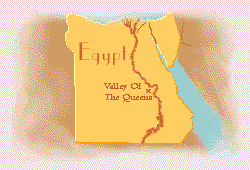
Exclusive
honors
Titles; "beautiful face" and "pretty with two feathers"
could be taken as reference simply to the queen's physical appearance. Another
describes her as "appeasing the gods". This expression is associated
with kings; and states their adherence to and support of the ritual requirements
of the cults. None of the Egyptian queens, so far as we know, had been held in
such honor, for none had a temple dedicated to her jointly with a goddess, as
was the case with Nefertari at Abu-Simbel..The temple facade has six statues,
each 33 feet high, four of them representing the king and two belonging to the
queen. The walls of the temple are adorned with various scenes; some represent
the pharaoh defeating his enemies while the queen stands behind him, others
represent the king and the queen bearing offerings in the presence of the
goddesses and deities, asking their blessings. The most interesting scene
represents the coronation of Nefertari by Isis and Hathor. There, the figure of
Nefertari stands at the side of the colossus of Ramses II and in the Ramseseum
temple. She is represented dancing
a ceremonial dance in front of the king during the feast of the god Min.
Her
own tomb
Ramses II has a tomb for Nefertari hewn out in the Valley of the Queens called
by the ancients "The Place of Beauty", this tomb is the most beautiful
in the Valley of the Queens, and is on the whole worthy of her position in
history. The decorative motifs on walls and ceilings are mythological and are
concerned with life in the netherworld, meetings with gods, deities, genii and
monsters, and the entry into the realm of eternity. In these scenes our queen is
represented always wearing long, transparent white garments, with two long
feathers over the vulture-like headdress of gold. She wears rich jewels, in
addition to bracelets and a wide golden collar.
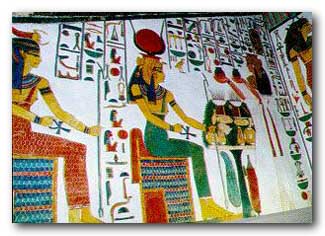
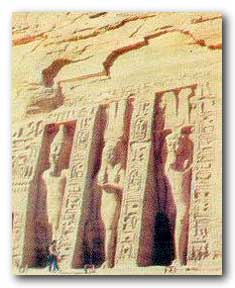
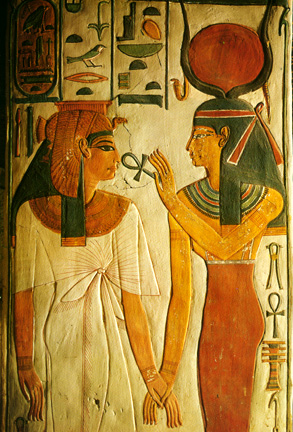
Description of the tomb
Outer doorway from entrance staircase into outer hall: the two lambs were
inscribed with the name of Nefertari. The lintel over the doorway is decorated
with a sundisk setting in the horizon flanked on both sides by Wadjet-Eye. The
scene also included a depiction of Isis and Nephthys in falcon form. Left and
right thickness of the door is decorated with the goddesses Nekhbet and Wadjet.
The Outer Hall has an almost square format of 5.20m by 5.30m. A rock cut bench,
with niches below it, designed to support part of the funerary equipment,
projects from the western and northern walls. The long inscription above the
bench is a rather garbled version of 17th Chapter of the Book of the Dead. The
upper register is filled with various scenes, serving as illustrative register
of the southern wall containing different scenes.
On the left, the queen is shown on a throne. In her right hand she holds a kind of wand, with the other she reaches for a game. The scene is placed in a kiosk made of reeds. Here the queen plays with her soul.
The next scene shows a bird with the queen's head, the Egyptian representation of the individual soul. The ba-bird is standing on a scale taking a shape of the tomb. The ba was a psychic force. The word was employed as a synonym of the manifestation of a god. Then the queen herself kneels in front of her soul, with hands uplifted in adoration of two juxtaposed lions, between them the sun's disk.
These
scenes of the two lions mean "yesterday and tomorrow" or "the
past and the future". Then, the graceful bird "benu" is the
representation of the phoenix, the sacred bird of Heliopolis. The phoenix was
regarded as the soul (ba) of Ra', but was also a manifestation of Osiris. The
bird benu is followed by a multiple scene consisting of a shrine with a bier on
which a prepared mummy of the queen is placed. This shrine is flanked on either
side by representations of both goddesses Isis and Nephthys. The next
scenes consist of two figures, one squatted bearded deity who holds a palm
branch, the other standing before him holding his two outstretched arms over two
squares. Next is the seated figure of a falcon headed deity before a largescale
"Sacred Eye". The decoration continues with the registers. They begin
at the left with the scene of a cow resting on a support. The next illustration
is a composite scene. Its center is a coffin with a jackal placed inside. It is
surrounded on both sides by two mummiform figures. The right part of the upper
register contains the four "Sons of Horus" accompanied by a fifth
apparently Horus himself. To the right is the Jackal- headed Anubis, the god
responsible for embalming. On the north side of the passage Osiris is shown in
his shrineIn the recess the thickness of the passage is decorated on both sides
with the representation of a goddess Selket (Scorpion). West inner face of the
recess, the decoration consists of a Djad pillar, the symbolic representation of
Osiris. North face of the recess, the scene shows the goddess Isis leading Queen
Nefertari to the right, in the realm of god Khepri. South face of recess is
decorated with a depiction of Harsiese (Horus son of Isis) holding Nefertari by
her hand and introducing her to Harakhty and the West (Hathor)...The scenes
decorating the west wall of the side room show the queen bringing linen offering
to Ptah. Behind the shrine of Ptah is a large Djad pillar, the symbol of Osiris.
The scene on the north wall shows Nefertari paying her respects to the god Thoth.
The left part of the wall is covered with a text of eight columns. It is a copy
of Chapter 94 of the Book of the Dead.
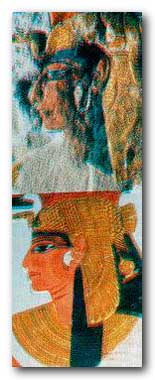
The east wall of side room is filled with two scenes separated in the center by an up-right standing fan. In the left scene the god Osiris is shown enthroned in the mummiform body, before him are the four "Sons of Horus". The queen is shown stretching her arm. The parallel right scene depicts the queen's offerings to god Atum. South wall of this side room is divided into three registers, the two upper being filled with seven cows and one bull. The bottom register shows four steering oars. On the following wall Nefertari with her raised arms in adoration is part of the adjoining last scene. The other panel on this west wall represents Ra' and Osiris united in the form of a ram-headed figure between Isis & Mephthys.
From the Outer hall a corridor, descending 18 steps continues the funerary designation of the tomb. The descent to the underworld is beautifully decorated. North thickness of upper part of West and East wall of corridor, the space is decorated with the Djad-pillar with two arms holding a scepters. Southern thickness of upper part of West and East wall is decorated with the goddesses Neith & Selket. Upper part of East wall corridor, the composition in the triangular space is arranged in the same way as on the opposite wall. On the left hand Nefertari offers two bowls of milk to goddess Isis behind whom sits Nephthys with Maat. On the right hand, Nefertari makes a similar offering to Hathor behind whom sits Selket, with Maat as before in the background.
Lower down there is a winged Uraeus, guarding two carts of the queen. The underneath, beginning about the kneeling figure of Maat, is another scene in which the Jackal Anubis stretched out on a tomb welcoming the queen. The bottom part of the east wall is decorated by the figure of Nephthys, while the parallel part of the west wall is decorated with Isis. The doorway lambs of the burial chamber are inscribed with the name and titles of Nefertari, while the sofas are decorated with a winged Maat. This corridor leads to that part of the tomb where the funeral ceremony was terminated and in which occurred the final transition to the burial chamber. The burial chamber is a relatively large rectangular room (10.40x8.50m) with four square pillars supporting the ceiling. Two side rooms and a small inner room are accessible from it. The entry walls to the burial chamber are adorned by four goddesses, while the walls are mostly decorated with scenes from the Book of the Dead. The queen is represented passing through nine gates from the domain of Osiris, which are guarded by dreadful demons. On the northern wall of the chamber she is shown before Osiris, Hathor, and Anubis. The four pillars form a kind of shrine to contain her sarcophagus, now lost. The pillars are decorated with the Djad pillar and various deities. The two side rooms flanking the burial chamber on the west and east are poorly preserved. An interesting scene on the eastern wall of the western side room shows Nefertari in the shape of a mummy. The function of the small inner room and two side rooms is not yet known because of their great obliteration.
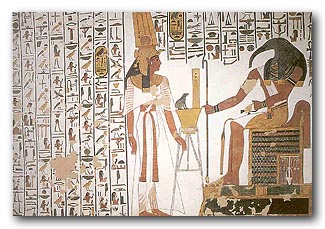
This
tomb is an ancient marvel with its bright living colors and amazing beauty. Of
all the tombs discovered in Egypt, the Tomb of Nefertari is the most colorful,
most dramatic and most well preserved. It is true there are many tombs
throughout Egypt, which are wonderfully decorated, but none is as vivid as
Nefertari's. The artisanís talent gives all those who enter this tomb the
overwhelming feeling time has stood still since 1255 BC when Nefertari died at a
young age.
The
biggest question in my mind as I witnessed this marvel was - how? How did it
remain in such pristine shape? I felt so honored to be present in Nefertari's
tomb.
In
1986, The Egyptian Antiquities Organization and the Getty Conservation Institute
combined their efforts to combat the demise of the paintings from the effects of
salt, moisture and flooding. The job was both time-consuming and extremely
delicate. There was to be no restoration of the paintings; only conservation
methods were to be used. In 1987, after thoroughly documenting the tombs'
features and decorations, the institute proceeded to temporarily bandage the
paintings that were separating from the walls. The conservationists used small
bandages of Japanese mulberry bark paper. Then, over a six-year period, the
meticulous work continued. The group was able to stabilize the deterioration
which had occurred.
The
biggest mistake I could have made would have been not treasuring every moment of
my time spent in Nefertari's Tomb.
Egypt is a beautiful country. Many of the works of the ancients have survived to this day to tell us their amazing story. Sometimes the artwork is in outstanding condition, other times the artwork is in ruins but in Nefertari's Tomb, the artwork is alive and it tells wonderful tales of what the Ancient Egyptians felt was in the other world. As I walked slowly into the tomb, the colors just jumped off the wall. My first reaction was the tomb was too beautiful to be authentic. As I slowly walked through savoring all of the details and realized this tomb has survived over 3,000 years, it made me smile. I smiled because I was proud - proud I was in Egypt to see this. I smiled because I was amazed - amazed at the wonders I was seeing. And I smiled because I was privileged, truly privileged to be in this amazing country. And I was privileged to be right in the center